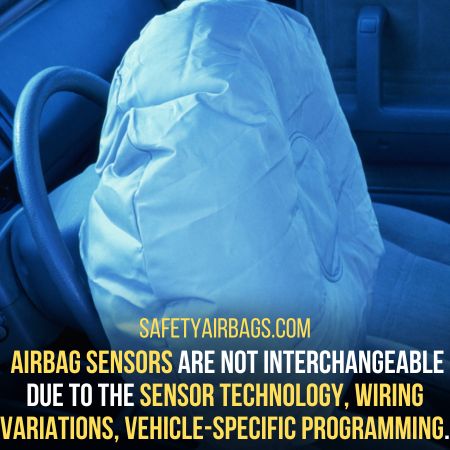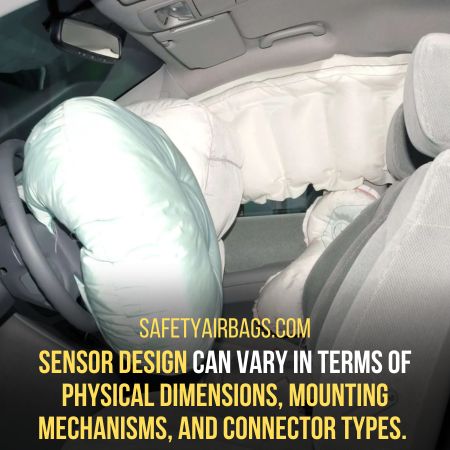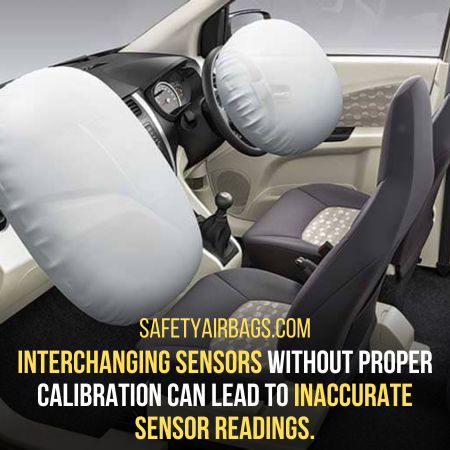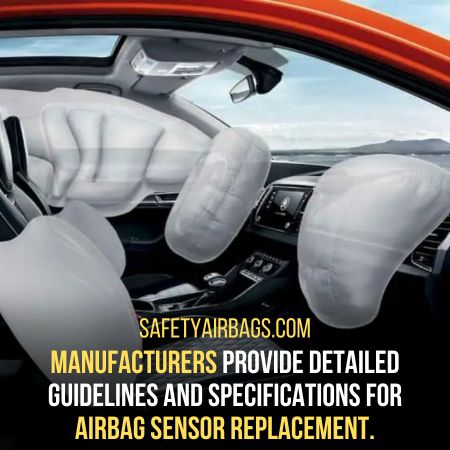Are airbag sensors interchangeable? Airbag sensors are not generally interchangeable due to sensor technology, wiring variations, and vehicle-specific programming.
What Will I learn
Interchanging airbag sensors without proper consideration can lead to incorrect calibration, faulty performance, and compromised occupant safety.
Are Airbag Sensors Interchangeable?
Airbag sensors play a critical role in vehicle safety, but it’s important to understand that they are not generally interchangeable.

Several factors determine the compatibility of airbag sensors, including the vehicle model, manufacturer specifications, and the importance of matching sensor specifications.
Compatibility Between Different Vehicle Models:
One of the primary considerations when it comes to airbag sensor interchangeability is the compatibility between different vehicle models.
Each vehicle model has its unique design and engineering, including variations in sensor placement, wiring, and programming.
These differences make it unlikely that sensors from one vehicle model will work properly in another.
Manufacturers design and calibrate airbag sensors specifically for their respective vehicle models to ensure optimal performance and occupant safety.
Manufacturer Specifications And Recommendations:
Manufacturers provide specific specifications and recommendations regarding airbag sensors for each vehicle model they produce.
These specifications outline the required sensor type, placement, wiring connections, and other important details.
They are based on extensive research, testing, and compliance with safety regulations.
It is crucial to follow these manufacturer guidelines to ensure that the airbag system functions as intended in the event of a crash.
Using sensors that are not recommended by the manufacturer can lead to compatibility issues, compromised performance, and increased risks to the vehicle occupants.
Importance Of Matching Sensor Specifications:
Matching sensor specifications is vital for maintaining the proper functioning of the airbag system.
Airbag sensors are designed to detect specific types of crashes or impacts and send signals to the airbag control module for deployment.
Different sensors are calibrated to respond to different force thresholds, acceleration rates, and impact angles.
Therefore, it is crucial to use sensors with matching specifications to ensure accurate crash detection and appropriate airbag deployment.
Mismatched sensors may result in delayed or premature airbag activation, potentially putting occupants at greater risk of injury.
Furthermore, occupant sensors are integrated into the airbag system to determine the presence and positioning of occupants.
These sensors include weight sensors and seat position sensors.
These sensors contribute to the system’s ability to tailor airbag deployment based on the occupants’ characteristics.
Using incompatible or mismatched sensors can compromise the accuracy of occupant detection.
It can potentially lead to inadequate protection or unnecessary airbag deployment.
Factors Influencing Interchangeability
When considering the interchangeability of airbag sensors, it’s important to recognize that several factors can influence compatibility.
These factors include sensor technology and design, wiring and connector variations, and vehicle-specific programming.
1. Sensor Technology and Design:
Sensor technology and design are significant factors that affect the interchangeability of airbag sensors.

Different manufacturers may employ varying sensor technologies.
These include accelerometer-based sensors or pressure-based sensors, to detect crashes or impacts.
These technologies have unique characteristics and response patterns.
They may require specific calibration and programming to function optimally within the airbag system.
Furthermore, sensor design can vary in terms of physical dimensions, mounting mechanisms, and connector types.
These design differences may impact the compatibility between sensors from different manufacturers or even different generations of the same manufacturer’s sensors.
Without proper consideration, attempting to interchange sensors with different technologies or designs can result in:
– Improper fitment
– Compromised signal transmission, or
– Inaccurate crash detection
2. Wiring And Connector Variations:
The wiring and connector variations present another significant challenge to the interchangeability of airbag sensors.
Each vehicle model may have specific wiring configurations and connector types.
They are tailored to accommodate the precise sensor requirements and ensure reliable electrical connections.
Incompatible wiring or connectors may lead to connection failures, incorrect signal transmission, or even damage to the airbag control module.
Moreover, connectors may have unique pin arrangements or coding, further complicating the interchangeability of sensors.
Manufacturers often design connectors to be proprietary, making it difficult to connect sensors from different sources without the necessary adapters or modifications.
It is essential to consider the wiring and connector specifications when attempting to interchange airbag sensors.
This can avoid electrical issues and ensure proper functionality.
3. Vehicle-Specific Programming:
Vehicle-specific programming is a critical factor that influences the interchangeability of airbag sensors.
The airbag control module, which receives signals from the sensors, is programmed to interpret and respond to specific sensor inputs.
It does it based on the manufacturer’s requirements and safety standards.
This programming includes crash detection algorithms, deployment thresholds, and occupant detection logic.
Interchanging sensors without updating or reprogramming the airbag control module can lead to compatibility issues.
The module may not recognize the signals from the new sensors or may misinterpret them, resulting in incorrect airbag deployment or failure to deploy in a crash.
Vehicle-specific programming ensures that the airbag system operates effectively and in accordance with the manufacturer’s intended functionality.
Considering these factors is crucial to ensure the proper interchangeability of airbag sensors.
Potential Risks And Consequences Of Interchanging Airbag Sensors
While it may be tempting to interchange airbag sensors, doing so without proper consideration can lead to significant risks and consequences.
It’s important to understand the potential issues associated with interchanging these sensors.
These include incorrect sensor calibration, faulty or inconsistent sensor performance, and compromised occupant safety.
1. Incorrect Sensor Calibration:
One of the primary risks of interchanging airbag sensors is the potential for incorrect sensor calibration.
Manufacturers calibrate sensors to specific vehicle models to ensure precise crash detection and appropriate airbag deployment.
Each sensor is fine-tuned to detect the force, acceleration, and impact angles that are relevant to the particular vehicle.
Interchanging sensors without proper calibration can lead to inaccurate sensor readings, resulting in delayed or premature airbag deployment.

For example, if a sensor with a higher force threshold is used in place of the original sensor, the airbags may not deploy in a crash that meets the necessary criteria.
Conversely, using a sensor with a lower force threshold may cause the airbags to deploy unnecessarily.
It can potentially causing harm to the occupants or interfering with the driver’s visibility.
2. Faulty Or Inconsistent Sensor Performance:
Another significant risk of interchanging airbag sensors is the potential for faulty or inconsistent sensor performance.
Sensors are designed, tested, and calibrated to meet specific performance standards set by the manufacturer.
They undergo rigorous quality control measures to ensure their reliability and accuracy.
Using sensors that are not specifically designed for a particular vehicle model can compromise their performance.
The sensors may not respond correctly to crashes or impacts, leading to unreliable or inconsistent readings.
Inconsistent sensor performance can result in unpredictable airbag deployment or a complete failure to deploy.
3. Compromised Occupant Safety:
Perhaps the most critical consequence of interchanging airbag sensors is the compromised safety of vehicle occupants.
Airbag systems are designed to provide effective protection during crashes.
They have sensors playing a crucial role in determining the appropriate deployment of airbags.
Using incompatible or mismatched sensors can compromise the accuracy of crash detection and occupant detection.
If the sensors fail to detect a crash accurately or do not detect the presence of occupants, the airbags may not deploy when needed.
Conversely, unnecessary airbag deployment due to mismatched sensors can also pose risks.
Unintended airbag deployment may cause injuries, especially if the airbags deploy at the wrong time or with excessive force.
Best Practices For Airbag Sensor Replacement
When it comes to airbag sensor replacement, following best practices is essential to ensure the safety and effectiveness of the airbag system.
These practices include consultation with qualified technicians, the use of genuine or OEM sensors, and compliance with manufacturer guidelines.
1. Consultation With Qualified Technicians:
Replacing airbag sensors is a complex task that requires technical expertise and knowledge.
It is crucial to consult with qualified technicians who have experience in airbag system maintenance and repairs.
These professionals can provide guidance on the proper sensor selection, calibration procedures, and installation techniques specific to your vehicle model.
2. Use Of Genuine Or OEM Sensors:
When replacing airbag sensors, it is highly recommended to use genuine or original equipment manufacturer (OEM) sensors.
Genuine or OEM sensors are designed and tested by the vehicle manufacturer to meet the specific requirements of the vehicle model.
They are calibrated to provide accurate crash detection and appropriate airbag deployment.
3. Compliance With Manufacturer Guidelines:
Manufacturers provide detailed guidelines and specifications for airbag sensor replacement.

It is crucial to comply with these guidelines to ensure proper sensor selection, installation, and calibration.
Manufacturer guidelines outline specific sensor types, placement locations, wiring connections, and programming instructions.
Potential Solutions for Interchangeability Challenges
In addition to best practices for airbag sensor replacement, there are potential solutions that can address the challenges associated with interchangeability.
These solutions include standardization efforts, retrofitting options, and advanced sensor technology advancements.
1. Standardization Efforts:
Standardization efforts aim to establish common guidelines and specifications for airbag sensors across manufacturers.
By standardizing sensor technology, design, wiring, and connectors, compatibility between different sensors and vehicle models can be improved.
Collaborative efforts among manufacturers, regulatory bodies, and industry organizations can drive the development of standardized interfaces and configurations.
2. Retrofitting Options:
Retrofitting offers a practical solution for improving interchangeability, especially in older vehicle models.
Retrofitting involves modifying or upgrading the existing airbag system to accommodate newer sensors or technologies.
By retrofitting the system, compatible sensors can be installed without compromising safety.
Retrofitting solutions may involve adapting wiring connections, updating the airbag control module, or using adapter modules to bridge compatibility gaps.
Conclusion:
In conclusion, the interchangeability of airbag sensors poses challenges that can impact the safety and effectiveness of the airbag system.
Factors such as sensor technology, wiring variations, and vehicle-specific programming need to be considered when replacing sensors.
It is crucial to consult with qualified technicians, use genuine or OEM sensors, and adhere to manufacturer guidelines to ensure proper sensor selection, calibration, and installation.
